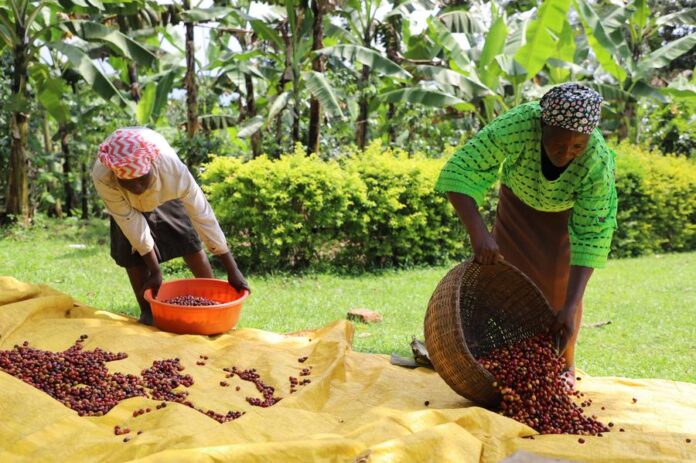The coffee bean has become a symbol of resilience and self-reliance for Africa and the Global South, bearing witness to a rising new tide from the Global South.
From „Originating in Africa” to „Out of Africa,” the humble coffee bean carries with it a painful legacy of colonization and exploitation, Xinhua reports.
Today, the magic bean has become a symbol of resilience and self-reliance for Africa and the Global South, bearing witness to a rising new tide from the Global South.
COFFEE CHERRY AND WHIP
„I had a farm in Africa, at the foot of the Ngong Hills. The Equator runs across these highlands, a hundred miles to the north, and the farm lay at an altitude of over six thousand feet.”
Karen Blixen, a Danish author, begins her 1937 memoir Out of Africa with this iconic line.
In the book, Blixen recounts her experiences from 1914 to 1931, during which she managed a coffee plantation in British East Africa, now Kenya.
Her reflections provide insight into the complexities of colonialism and the personal transformations she underwent during her time in Africa.
In the late 19th century, driven by profit motives, Western colonial powers forcibly seized land from indigenous communities in East Africa to establish plantations for cash crops like coffee.
In 1893, French missionaries introduced coffee to Kenya, planting the first Bourbon variety seeds from Reunion Island near Nairobi. Two years later, in 1895, the British government declared the region the British East Africa Protectorate, and by 1920, it had become the Kenya Colony under direct British colonial rule.
Recognizing the profitability of cash crops, the British colonial administration prioritized the cultivation of coffee. They identified the central highlands – characterized by fertile volcanic soils, elevations between 1,500 and 2,100 meters and a temperate climate – as ideal for Arabica coffee farming, leading to the rapid commercialization of coffee cultivation in Kenya.
Land was among the foremost targets of colonial plunder. In 1902, the British colonial administration enacted the Crown Lands Ordinance, declaring all land within the East Africa Protectorate as Crown Land under the authority of the British monarch.
This legislation permitted the sale or lease of parcels of land of up to 1,000 acres by authorized officials, with leases commonly set at 99 years. The most fertile regions, particularly in Kenya’s central highlands, were designated as the „White Highlands” and reserved exclusively for European settlers.
Indigenous communities, notably the Kikuyu and Kalenjin peoples, were forcibly displaced from their ancestral lands and relocated to less arable reserves. Under stringent colonial policies and burdensome taxation, many local inhabitants not only lost their land but were also compelled to serve as cheap labor on settlers’ farms.
Maina Kiarie, curator at the Enzi Museum in Kenya, said the European settler population in regions designated as the „White Highlands,” including Nanyuki, Nyahururu and the Uasin Gishu area, was approximately 100 in 1903. By 1950, this number had surged to over 80,000.
By 1960, around 2,000 European settlers each owned farms exceeding 2,000 acres, reflecting the extensive land consolidation by European settlers during the colonial period.
In „Out of Africa,” Blixen reflects on the exploitation of local tenant farmers by European landowners.
On her 6,000-acre farm, approximately 1,000 acres were cultivated by tenant families. These tenants, whose parents had also been born and raised on the estate, were indigenous to the land yet held no ownership rights.
„The squatters were natives, who lived on the farm with their families and cultivated their little shambas there. In return for this, they had to work for me a certain number of days in the year,” she wrote.
During the colonial era, European settlers prohibited indigenous Kenyans from cultivating coffee themselves, said Karuga Macharia, vice chairman of the African Fine Coffees Association based in Kenya.
„They were forcibly removed from fertile lands and relegated to laboring on settler-owned coffee plantations, often under exploitative conditions,” Macharia told Xinhua.
The colonial coffee industry was structured primarily for the export of raw coffee beans to Europe, where processing and sales occurred, leaving local communities with minimal economic benefit despite the crop being grown on their land, he said.
Meanwhile, Chris Oluoch, programmes director at Fairtrade Africa, highlighted the enduring impact of colonialism on Kenya’s coffee industry.
Today, Kenyan local producers often find themselves compelled to engage in the coffee trade through multinational corporations based in Western countries, he said.
Uganda, Kenya’s neighbor, became a British protectorate in the late 19th century.
During the colonial period, British authorities actively promoted tea cultivation, encouraging the local population to adopt tea as their primary beverage.
Meanwhile, Uganda’s coffee production was geared almost entirely towards export. This export-oriented approach meant that, despite being a major coffee producer, domestic consumption remained minimal.
In Uganda, the legacy of British colonialism continues to influence the perceptions of coffee. A coffee brand named „kiboko,” meaning „hippopotamus” in Swahili, also refers to a whip traditionally made from hippopotamus hide.
During colonial times, British overseers used such whips to enforce labor on coffee plantations, leading to the association of coffee with forced labor among Ugandans.
This historical context has contributed to the perception of coffee as a „white man’s drink” in Uganda. Many locals have traditionally viewed coffee primarily as a cash crop for export rather than a beverage for local consumption.
INDEPENDENCE AND STRUGGLES
In the 1950s and 1960s, Africa witnessed a surge in national liberation movements.
On Dec. 12, 1963, Kenya gained independence from British colonial rule. However, the departure of the colonizers did not dismantle the economic structures they had established.
Coffee, introduced during the colonial era as a primary cash crop, became a double-edged sword in Kenya’s post-independence economic development.
While it generated foreign exchange earnings, it also contributed to food insecurity, rural poverty and entrenched inequalities within the agricultural value chain.
In the early years following independence, the Kenyan government continued the colonial economic model, allocating vast tracts of land to the cultivation of cash crops like coffee and tea.
This focus on export-oriented agriculture brought in foreign revenue but marginalized food production, leading to reduced domestic food supplies.
While merchants and exporters profited, many farmers remained impoverished. In rural Kenya, protests frequently erupted over the low prices offered for coffee, reflecting widespread discontent among smallholder farmers.
In the heart of Nairobi, a white-and-green high-rise building, home to the Nairobi Coffee Exchange (NCE), still stands. Established in 1935, the institution from the colonial era continues to dominate Kenya’s coffee export.
„We are still deeply reliant on international markets, exporting mostly semi-processed coffee beans. As a result, the majority of profits are captured by middlemen and developed countries, leaving our farmers with just a fraction of the final retail value,” said Dennis Munene Mwaniki, executive director of the China-Africa Center at Kenya’s Africa Policy Institute.
The majority of Kenyan coffee is exported in semi-processed form through the NCE, a system established during colonial rule, he said, adding that this structure limits Kenya’s control and influence over the coffee value chain.
„This approach is one of the reasons behind the challenges facing Kenya’s coffee industry today,” he said.
Pricing at the NCE is largely determined by a few international buyers and local intermediaries, leaving local coffee farmers with little choice but to accept the prices offered.
The coffee industry’s business model is based on a type of neo-colonialism, dominated by a handful of transnational coffee merchants whose profits are bountiful, said a commentary on Australia’s The Conversation website.
„Over 80 percent of the world’s coffee comes from 25 million small-scale farmers and 60 percent is produced by farmers on less than 5 hectares. Many of them struggle to make a decent living,” it said.
Kenyan coffee farmers exemplify this disparity. While a cup of coffee in European specialty cafés typically costs around 4 U.S. dollars, many Kenyan coffee laborers earn at most 2.3 dollars per day.
For Ethiopia, despite the global acclaim and high retail prices of Ethiopian coffee, only about 5 to 10 percent of the final retail price returns to Ethiopia.
The majority of profits are captured by international distributors and brokers. Consequently, many Ethiopian coffee farmers earn as little as 500 dollars annually, despite their year-round labor, according to data from the World Bank.
Meanwhile, in Uganda, the coffee industry is similar to that of other African countries, as it continues to grapple with the enduring legacies of colonial economic structures.
Nelson Tugume, chairman of Inspire Africa Group, said that this profound inequity not only demoralizes coffee farmers but also impedes the sustainable development of Africa’s coffee sector.
He called for a more equitable and reasonable allocation of the substantial wealth generated by the global coffee trade, asserting that African coffee farmers deserve a fairer share of the profits.
XINHUA




